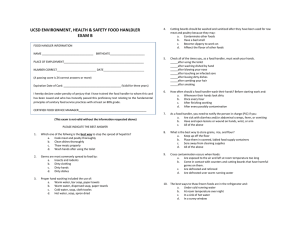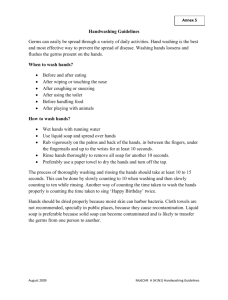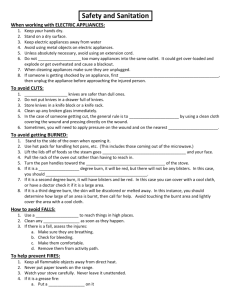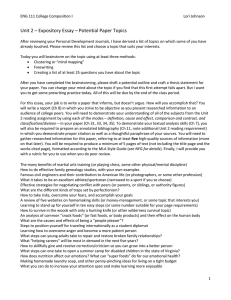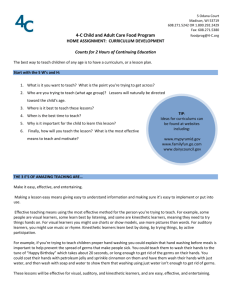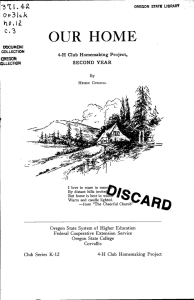UCSD ENVIRONMENT, HEALTH & SAFETY FOOD HANLDLER EXAM A
advertisement
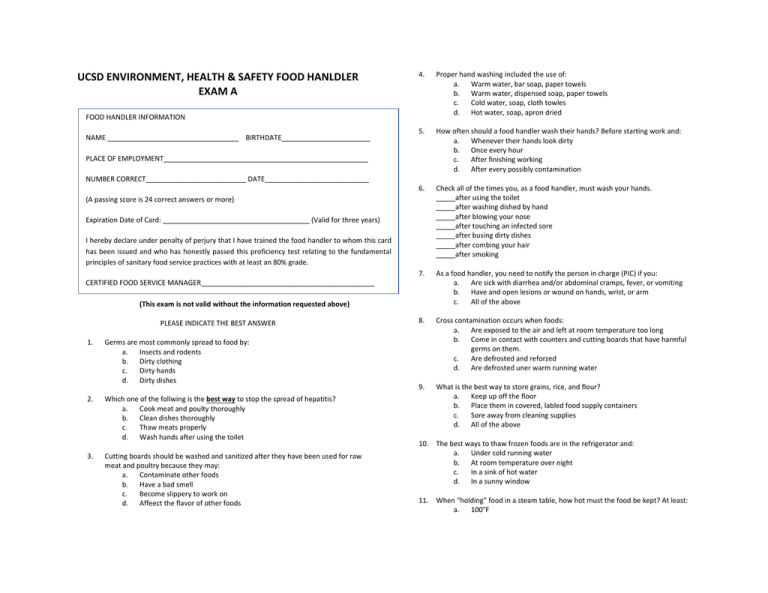
UCSD ENVIRONMENT, HEALTH & SAFETY FOOD HANLDLER EXAM A 4. Proper hand washing included the use of: a. Warm water, bar soap, paper towels b. Warm water, dispensed soap, paper towels c. Cold water, soap, cloth towles d. Hot water, soap, apron dried 5. How often should a food handler wash their hands? Before starting work and: a. Whenever their hands look dirty b. Once every hour c. After finishing working d. After every possibly contamination 6. Check all of the times you, as a food handler, must wash your hands. _____after using the toilet _____after washing dished by hand _____after blowing your nose _____after touching an infected sore _____after busing dirty dishes _____after combing your hair _____after smoking 7. As a food handler, you need to notify the person in charge (PIC) if you: a. Are sick with diarrhea and/or abdominal cramps, fever, or vomiting b. Have and open lesions or wound on hands, wrist, or arm c. All of the above 8. Cross contamination occurs when foods: a. Are exposed to the air and left at room temperature too long b. Come in contact with counters and cutting boards that have harmful germs on them. c. Are defrosted and reforzed d. Are defrosted uner warm running water 9. What is the best way to store grains, rice, and flour? a. Keep up off the floor b. Place them in covered, labled food supply containers c. Sore away from cleaning supplies d. All of the above FOOD HANDLER INFORMATION NAME __________________________________ BIRTHDATE_______________________ PLACE OF EMPLOYMENT_____________________________________________________ NUMBER CORRECT__________________________ DATE___________________________ (A passing score is 24 correct answers or more) Expiration Date of Card: ______________________________________ (Valid for three years) I hereby declare under penalty of perjury that I have trained the food handler to whom this card has been issued and who has honestly passed this proficiency test relating to the fundamental principles of sanitary food service practices with at least an 80% grade. CERTIFIED FOOD SERVICE MANAGER_____________________________________________ (This exam is not valid without the information requested above) PLEASE INDICATE THE BEST ANSWER 1. Germs are most commonly spread to food by: a. Insects and rodents b. Dirty clothing c. Dirty hands d. Dirty dishes 2. Which one of the follwing is the best way to stop the spread of hepatitis? a. Cook meat and poulty thoroughly b. Clean dishes thoroughly c. Thaw meats properly d. Wash hands after using the toilet 3. Cutting boards should be washed and sanitized after they have been used for raw meat and poultry because they may: a. Contaminate other foods b. Have a bad smell c. Become slippery to work on d. Affeect the flavor of other foods 10. The best ways to thaw frozen foods are in the refrigerator and: a. Under cold running water b. At room temperature over night c. In a sink of hot water d. In a sunny window 11. When “holding” food in a steam table, how hot must the food be kept? At least: a. 100°F b. c. d. 135°F 150°F 160°F 12. Which food must be stored at or below 41°F? a. Chicken salad b. Strawberry jam c. Whole tomatoes d. Peanut butter sandwiches d. All of the above 18. What is the best way to control cockroaches? a. Clean equipment and store food properly b. Inspect incoming boxes and other containers c. Fill in cracks where cockroaches hide d. All of the above CIRCLE THE CORRECT ANSWER 13. When reheating leftovers or when cooking poultry, the center of the food must be at least: a. 165°F b. 100°F c. 50°F d. 212°F 19. T F Raw foods can be stored next to reay-to-eat foods. 20. T F Consumers must be notified orally or in writing of foods served raw or undercooked unless specifically ordered or is common knowledge. 14. Which of the following types of foods are most likely to cause foodborne illness? a. Bread and cereal products b. Foods containing lots of sugar c. Foods such as meat, milk, and eggs d. Citrus fruit and fruit juices 21. T F Ice cannot contain germs because it’s frozen. 22. T F Raw fruits and vegetables must be washed before served 23. T F Soap or detergent will kill all disease-causing germs on dishes. 15. Number the following items in their correct order for proper washing? ______rinse ______scrape ______air dry ______sanitize ______wash 24. T F It is okay to use chipped or chracked dishes as long as they are clean. 25. T F Every refrigerator must have an accurate thermometer 26. T F Hot foods are allowed to cool to room temperature for any period of time before they are put in the refrigerator. 27. T F Handwashing signs must be posted at all handwashing sinks and food preparation areas 28. T F Food waste and garbage should be put in strong plastic bags and disposed of at lest once a day. 29. T F Food handlers must cover or restrain their hair while working 30. T F Cooking food kills the germs in food. 16. When washing dishes in a three-compartment sink, what should the third sink be used for? a. Sanitizing dishes b. Washing hands c. Rinsing dishes d. Storing equipment 17. Approved food sources include: a. Foods permitted or licensed with a food regulatory agency b. Raw and processed meat and poultry with a USDA stamp of approval c. Cheese from a licensed distributor with proper labels
